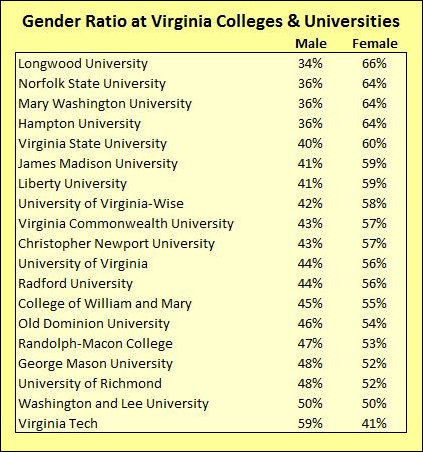Jon Birgir, author of “Date-onomics: How Dating Became a Lopsided Numbers Game,” advances a fascinating theory on how the ratio of the sexes in U.S. colleges affects dating behavior. In colleges with more men, “traditional” dating patterns predominate, while colleges with more women tend to have more intense hookup cultures.
The irony is that the dating culture isn’t established by the majority gender but the minority. In male-dominated campuses, women are in greater demand, hence are in a better position to set the terms of the relationship. Conversely, in female-dominated campuses, men are in greater demand, and they set the terms of the relationships. Insofar as college-age men are more interested in engaging in sex rather than establishing long-term relationships, the campus culture tilts toward a hook-up culture.
Thus, according to Birgir’s theory, the decades-long trend in which male-dominated campuses have evolved into female-dominated campuses has tilted the dating supply-and-demand equation decisively in favor of men. The result: boorish, sophomoric, sex-obsessed college males have an outsized say on the college dating culture. Says Birgir in a Washington Post interview:
It’s not just the social science I cite in the book, you can really see it in how kids talk about dating life at those schools.
I use data in the book from Niche.com, which is a college review site. At the schools that are predominantly male, the kids talk about how students like to be in relationships. So for Georgia Tech, which is 66% male, the comment on Niche.com was, “Tech is a fairly monogamous campus.” But for the schools that are skewed female, the hookup culture becomes more intense. So James Madison, which is 63% female, one comment is, “The deficiency of guys creates a scene that tends to embrace random hookups. …
People should know generally that the average gender ratio on campus these days is 57 to 43, which is one-third more women than men, and that is going to lead to a more libertine, a looser sexual culture on campus.
Now, let’s close the loop on the “epidemic of rape” issue I’ve been dissecting on Bacon’s Rebellion. I would argue that rising incidence of rape on Virginia college campuses (and campuses nationally) does not reflect a growing number of the violent encounters, often at gunpoint or knifepoint, that we traditionally thought of as rape but an outgrowth of the alcohol-fueled hookup culture that tends to be — this is a generality, and all generalities have exceptions — more gratifying to men than to women. A result of the hookup culture is that there are many unhappy women on college campuses today. Too many engage in sex that they hope will lead to a lasting relationship only to have their hopes dashed, often cruelly; they come to regret their action, and under the prevailing doctrine emanating from the U.S. Department of Education and arising from campus anti-rape movements, such encounters are now interpreted as rape. It is also possible that a growing number of men feel entitled to sex and that, after bouts of drunken making out, some of them resort to coercion to get what they want.
The gender ratio is not the only factor influencing the campus dating/sex culture. Administrative policies have an influence. So does the cultural background of the student body. The gender ratio at Liberty University, for instance, is more lopsided than it is at the University of Virginia, but I would be very much surprised if the hookup culture at that evangelical university is anywhere near as intense, if it exists at all. Similarly, I would conjecture that commuting campuses, in which student bodies are geographically dispersed, have less intense hookup cultures than campuses in which young men and women are thrown together in dormitories and have easy access to one another.
Yet Birgir’s hypothesis makes a lot of sense to me. Now, to take his conjecture to the next step…. I don’t believe there is any reliably comparable data on the number of complaints about sexual assault on Virginia campuses, but if there were, I would predict a meaningful correlation between the incidence of such complaints and the gender ratio of the student body.
What conclusions can we draw? One tentative conclusion is that student bodies with more balanced gender ratios are less likely to have hookup cultures and complaints of sexual assault than student bodies dominated by females. Insofar as the “epidemic of rape” is tied to the rise of the hookup culture, anything that restores more traditional dating patterns would be beneficial. Unfortunately, it is all but impossible to achieve balanced gender ratios across the board when, for biological and cultural reasons, women are far more better prepared for college and are admitted in much higher numbers. There is little appetite in American culture, even one supposedly dominated by the male “patriarchy,” for undermining the meritocratic principle of college admissions.
Birgir suggests another solution, although it won’t have much impact on college campuses for another 15 years or so — holding boys back in pre-school. Giving boys an extra year to mature in school, he suggests, will make them more competitive in college applications. Says Birgir: “If we essentially red-shirted boys and had them begin kindergarten a year later than girls, it would go a long way to closing this gap.”



